Archived Why SERVPRO Blog Posts
Can a Property Manager Be Sued for a Mold Claim?
8/15/2022 (Permalink)
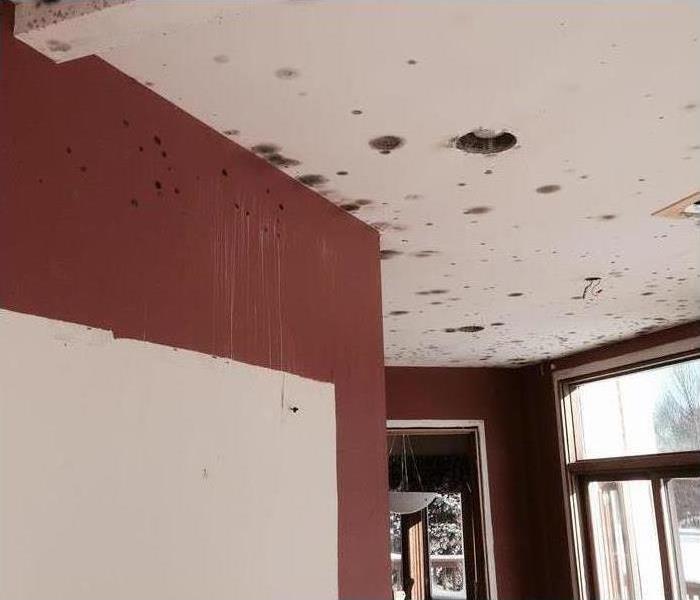 Mold damage in Geneva, IL
Mold damage in Geneva, IL
Mold insurance claims are on the rise. In one major case, a Texas couple was awarded $4 million due to mold damages. Tenants are getting more litigious by the year, so it behooves property managers to know what their responsibilities are regarding mold remediation.What Can Cause a Mold Claim?
A building owner in Geneva, IL, may be responsible for situations leading to property damage in the case of provable negligence. Most mold claims against property managers revolve around three issues:
- Improper building materials
- Improper repair techniques
- Damage caused during repairs
Residential landlords are held to the highest standard and are strictly required to maintain a “habitable” dwelling. Business tenants are not typically held to the same standard since they’re assumed to have a higher level of sophistication and responsibility for their own fate.
Any of these three issues are the property manager’s responsibility, even if you used a contractor to do the work. You may be able to sue the contractor for damages, of course. If the mold damage is the result of a water leak, it may be covered by mold insurance claims, especially if you have a rider for mold.
What Is Your Liability?
For business tenants, your liability is typically described in your contract. However, even if your contract makes your tenants responsible for maintenance, some problems may still be considered your responsibility. Your attorney can help you determine where this sometimes-obscure line is.
How Can You Reduce Your Liability?
Since the building is your asset, you should arrange for a yearly mold inspection by a local mold restoration company. Black mold can eat away at construction materials and even weaken the structure if it’s made of wood. Don’t assume the tenants will care about your building!
You should also review your contract with your attorney. However, the best way to reduce liability and prevent the stress of making mold insurance claims is prevention. If you have a water leak, regardless of the source, get it fixed immediately to avoid future mold damage and claims.
4 Ways to Keep Mold From Spreading In Your Home
7/30/2022 (Permalink)
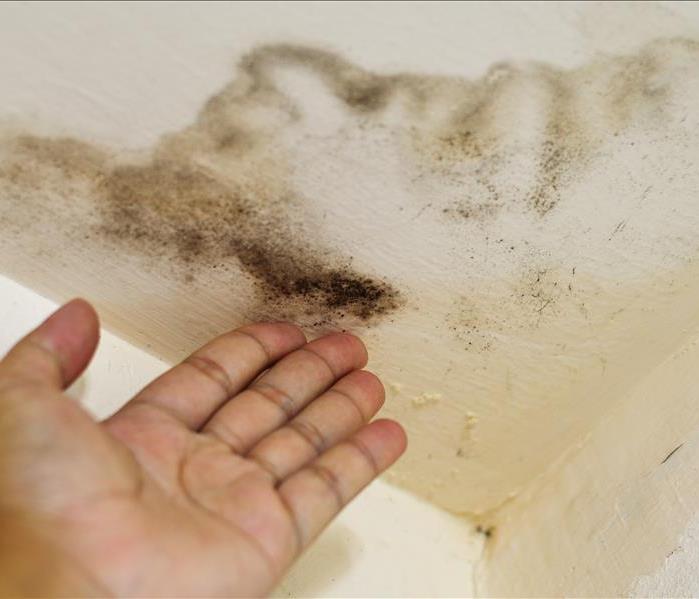 The aftermath of Mold damaging the ceiling after water damage.
The aftermath of Mold damaging the ceiling after water damage.
Four Strategies to Prevent Mold Growth in Your Home
Mold is a common problem for many homeowners, but this fact doesn’t make it any less frustrating. If you have mold growth in your St. Charles, IL, home, there are several things that you can do to help keep it under control.
1. Reduce Moisture
Mold needs moisture to grow. This is why you will often find mold in places with water damage. However, your house doesn’t need to be flooded to enable this growth. Small leaks or high levels of humidity can contribute as well. Fixing damaged pipes or appliances quickly and using dehumidifiers can help prevent mold.
2. Limit Air Circulation
If you already have mold in your home, whether as a result of water damage or something else, movement in the air can spread it further. Limit the use of HVAC systems and fans until you are able to have the mold removed.
3. Clean Regularly
Because mold can grow in any location and you may not know that any spores are present before they have begun to spread, cleaning your home regularly is an important part of mold prevention. This is especially true if you have had mold problems in the past. In areas that mold has grown previously, you are more likely to find future growth.
4. Hire a Professional
Mold can be difficult to remove on your own and can easily be spread if you don’t know what you’re doing, so hiring a mold remediation company to remove it can help keep the problem from returning. They can find all instances of growth in the building and can perform cleanup and any needed repairs.
Even if mold keeps popping up in your house, there is no need to panic. In most instances, it will not cause serious problems. Just be sure to take care of any water damage when it occurs and keep moisture levels low. Recurring mold should be handled by a professional to get the best results.
Local Is Better: Why SERVPRO Is a Preferred Vendor
4/26/2022 (Permalink)
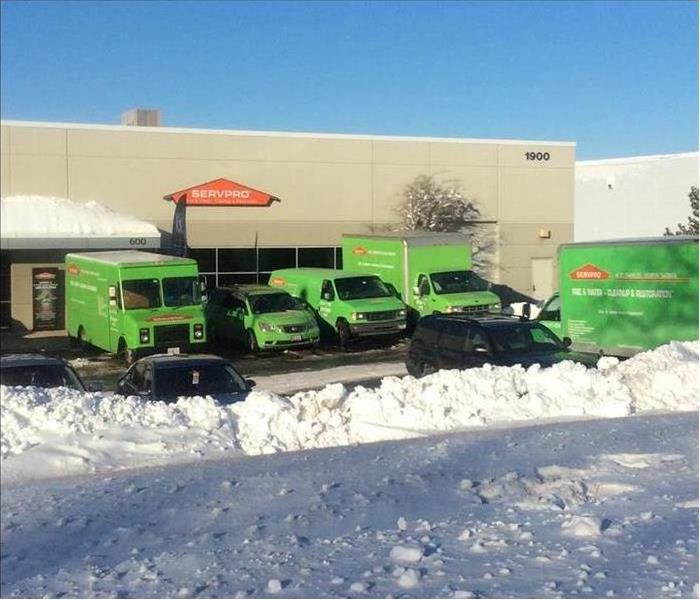 SERVPRO St. Charles/Geneva/Batavia provides peace of mind during your restoration.
SERVPRO St. Charles/Geneva/Batavia provides peace of mind during your restoration.
Why SERVPRO Is a Preferred Vendor
When your company in Geneva, IL, is faced with damage from fire, water, or mold, you want the decision about who to hire for restoration services to be simple. Unless you've done a lot of research in advance, it can seem daunting to need to shop around for quotes and availability when you just want the job done. Many insurance companies will have a list of preferred vendors in your area. The local SERVPRO franchise will be a good bet.
1. SERVPRO Is Local
You're a business owner in the community so you understand the importance of supporting other local business owners. SERVPRO is a national corporation that has locally owned and operated franchises. When hiring someone to do a big restoration project, it's important that they do business nearby and are invested in you and the community.
2. SERVPRO Is Certified
When your restoration project is completed, you want your customers to know that you had the job done and done well. A certified SERVPRO clean is a set of high standards that promises a thorough cleaning of your space with the interest of keeping you and your customers safe. Because local franchises are backed by big corporate standards, the SERVPRO Certified label means the same level of excellence no matter where you are.
3. SERVPRO Is Resourced
Locally owned small businesses are wonderful for the economy and the community. The helpful thing for a small business that is part of a larger corporation, like a SERVPRO franchise, is that they have access to resources that other non-franchises might not. This is beneficial to you as the business owner when something unexpected comes up during the restoration process. You know that the company you hired is supported, which in turn helps them to better support you.
Check with your insurance company to find out who is on their list of preferred vendors. Working with a SERVPRO franchise in your community will provide peace of mind during your restoration.
With Its 24-Hour Response, SERVPRO Is Your Top Choice for Disaster Recovery
2/16/2022 (Permalink)
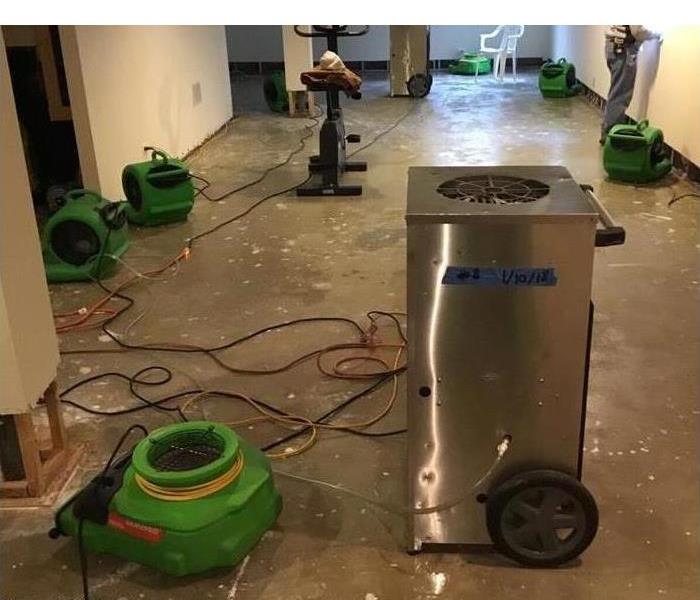 Water damage restoration services in a home in St. Charles, IL.
Water damage restoration services in a home in St. Charles, IL.
Eventually, something in your home will break or wear out. Replacement and repairs are inevitable. You can handle some things on your own, and some things aren’t that urgent and can wait for attention. But with a home disaster such as a flood or fire, it’s a different story. In a situation such as this, you need an experienced professional that can provide 24-hour service to relieve your desperate emergency. Look no farther than SERVPRO.
What Makes SERVPRO Great?
SERVPRO isn’t the only disaster recovery company around, but it should be your No. 1 choice when you need thorough, efficient restoration and cleanup help from a catastrophe at your St. Charles, IL, house. Here are a few reasons why:
- SERVPRO is always open.
- SERVPRO has years of experience.
- SERVPRO does pretesting, cleanup, and restoration.
Round-the-Clock Care
Have you ever had an urgent need, so you called a professional for help, but the person or company had shut down shop for the rest of the day? This can be frustrating if you need to correct the problem immediately. Luckily, SERVPRO can give you a fast response because it never closes its doors. Someone is always available to respond to your issue, whether it’s late at night, on the weekend or even on a holiday.
Experience Matters
You can have peace of mind knowing that not only does SERVPRO give you 24-hour attention, but that it has a proven track record of success in the industry. The team has years of experience helping customers just like you with small jobs, extensive jobs and everything in between.
Full Range of Service
From the moment you enlist the help of a SERVPRO professional, you can expect thorough service. The team will first assess the damage and come up with a game plan. Then, the technicians will remove water and smoke damage, clean up and sanitize the affected area, and restore or replace what you lost in the disaster.
There’s no need to call anyone else when you can have SERVPRO and its 24-hour service in your home. When disaster strikes, you know where to turn.
3 Steps for Creating Green Flood Prevention
11/26/2021 (Permalink)
 Pay attention to where you place landscaping.
Pay attention to where you place landscaping.
Three Steps to Green Flood Prevention
With the extreme weather created by global warming, business owners in North Aurora, IL, now have to think about flooding. Flood damage is a major hassle. Fortunately for you, there are three steps that can help you create green protection from storm damage.
1. Observe
The first step is to observe water flow and drainage around your business. Watch where the water goes during the next storm. Look for sources of running water. You may need to watch out for a small river from further up your street or off a neighbor’s roof.
Drainage is important for avoiding storm damage. Keep storm drains clear of debris. Check with your local government to see who is responsible for maintaining drains around your business.
2. Assess
Assess the drainage capability of the area surrounding your business. Asphalt and concrete don’t absorb any rain water. Even if you have grass or other landscaping, take a poke at it after the next rain storm. How well does water drain through that soil?
Walkways and the base of stairs are notorious for creating small pools. Does this happen around your business? How do they dry up? Would they contribute to flooding?
3. Create
Your landscaping can serve as a first barrier to floodwaters. A high berm with well-rooted shrubbery is far more attractive than a wall of sandbags. The same can be said of raised garden beds that create a welcoming atmosphere for your customers and clients. A rain garden is also an attractive way to prevent flood damage. These gardens purposely hold onto water and allow it to drain into the ground below.
Pay attention to where you place landscaping. The last thing you want to do is redirect water into your building. Think of the spaces between green areas as pathways for water. If you share a building with other businesses, landscaping and flood prevention is a shared investment in which all have a stake.
Flood damage can be minimized or avoided by taking certain preventative steps. However, should damage occur, contact recovery professionals as quickly as possible.
3 Fast FAQs About Mold
10/7/2021 (Permalink)
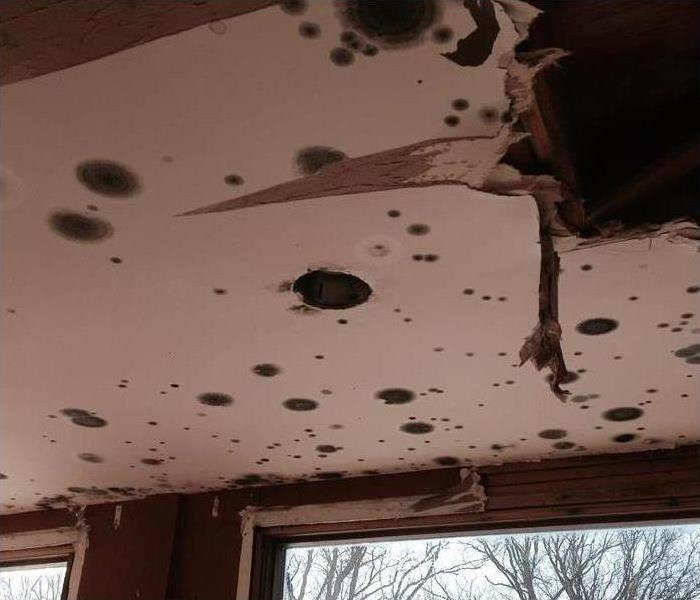 Mold damage in a Geneva, IL home.
Mold damage in a Geneva, IL home.
Mold: 3 Quick Answers
Treating mold growth in your Geneva, IL, home can be a daunting task. No matter what type you are dealing with or what caused it, eradicating it for good usually requires the assistance of a mold removal and cleanup company. However, asking a few questions about the growth, treatment and nature of this fungi may help you understand it a bit better and even help you prevent another invasion in the future.
1. What Causes Mold To Grow?
Mold spores are common in the air and can be found both indoors and out. However, when they find an environment with high humidity or dampness, they attach themselves to organic matter and multiply rapidly. Since mold does not require sunlight to grow, it can thrive in dark places, such as under cabinets, around toilet bases and in basements. The more moisture there is, the better the chances for mold growth.
2. What is Mold Remediation?
Once mold is discovered in your home and you call in a professional cleanup team, the technicians may perform immediate remediation to ensure the patches do not spread into other rooms. Remediation is meant to isolate the spores, which is usually performed with specialized tools, such as negative air chambers. This type of preventative care allows the technicians to move ahead with tear out work without risking the further spread of fungi spores.
3. How I Can Prevent Mold in the Future?
One of the most effective ways to prevent the spread of mold in the future is to monitor your home’s plumbing and water lines. Water damage can cause leaks and puddling, and since moisture attracts mold spores, preventing these conditions may lower the risk of infestation. Keeping your home’s humidity levels low may also discourage mold from forming.
Calling in a professional mold growth eradication team is a wise choice when you find fungi in your Geneva, IL, home. Being prepared with a short list of questions may allow you understand the cleanup process more thoroughly and help you prevent mold from returning in the future.
Comparing and Contrasting Mold and Mildew
9/10/2021 (Permalink)
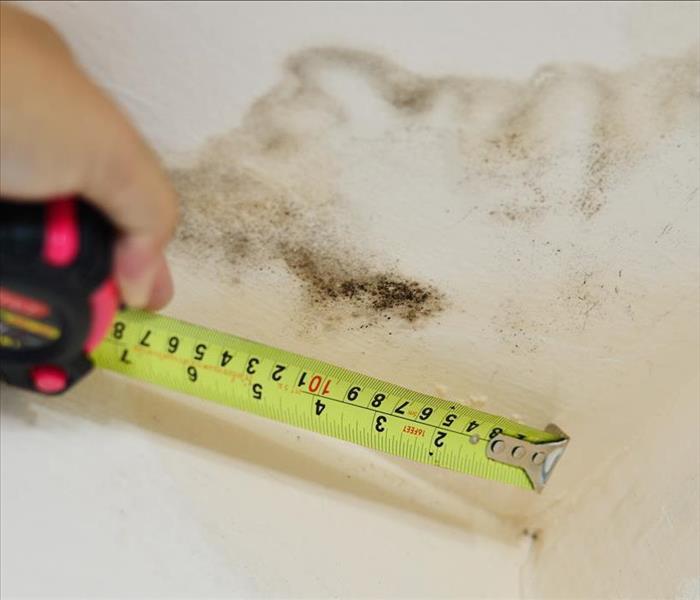 Generally speaking, materials that have sustained mold damage will not be salvageable because the infiltration is not superficial.
Generally speaking, materials that have sustained mold damage will not be salvageable because the infiltration is not superficial.
As any homeowner in St. Charles, IL, can attest, the unwelcome appearance of mold and mildew might be a matter of when not if. Both can proliferate in many environments, needing only moisture and nutrition to colonize quickly. And while they share many similarities, there are some significant differences in how to remediate them once they’ve taken up residence. Mold damage is typically more serious than mildew.
Fungi Unknown Facts
There are roughly 100,000 known types of fungi throughout the world, and some are not only beneficial but also delicious, such as mushrooms. What makes them unique from other types of plants is that they digest their nutrition externally before absorbing it. Both mold and mildew are fungi and can thrive on porous materials found in homes such as:
• Paper
• Wood
• Walls
• Insulation
• Fabric
Mildew Versus Mold
Mildew is white, whereas mold can take on many colors, including red, green, blue, orange, and black, depending on the species. Because mildew stays on the surface of the material on which it grows, removing it can be simple if the surface can be scrubbed with a cleaning solution in a well-ventilated area. Mildew can be thought of as a nuisance and a benign indication that there is too much moisture collecting in a given area.
Mold damage, on the other hand, infiltrates porous surfaces that have been exposed to excessive humidity or water, and it is more challenging to remediate. It is best to allow professionals to step in and make an assessment. The first step is to identify the source of moisture and address it. Materials like wallpaper and drywall are likely to require replacement. Once the mold growth has been removed, there are products on the market that inhibit regrowth, such as specially treated drywall and paints.
Generally speaking, materials that have sustained mold damage will not be salvageable because the infiltration is not superficial. Keeping a home as dry as possible can inhibit mold and mildew growth.
How To Choose an Air Purifier To Remove Mold Particles From the Air
8/27/2021 (Permalink)
 SERVPRO has the right people trained and the right equipment ready for any of your mold needs.
SERVPRO has the right people trained and the right equipment ready for any of your mold needs.
How to Pick An Air Purifier To Get Mold Particles Out Of The Air
Battling mold in your St. Charles, IL, home can be a challenge. Mold tends to spread quickly and reduces your home's air quality, and once it takes hold, it can cause an unpleasant odor and damage building materials. Using quality air filtration in your home can eliminate mold particles from the air; however, there are a few factors you may want to consider as you compare different brands and models to choose a system that best suits your needs.
Filter Quality
The quality of the filter in an air purifier can make a significant difference when it comes to removing mold particles from the air. Generally, systems with HEPA filters, such as in the Oransi Max, are effective in removing not only mold spores but other impurities:
Consulting a restoration and mold remediation company before choosing a system with a high-quality HEPA filter can help you feel confident about removing damaging mold particles from the air before they can take hold inside your home.
Ease of Use
Air filtration systems that remove mold spores from the air and are designed for convenience can be a good choice if you want clean air with a push of a button. These models, such as the Oransi OV200, have a user-friendly design and can be operated with a remote control. Other features include an air quality sensor and a HEPA filter.
Budget
Working with a limited budget does not have to mean foregoing an air filtration system for your home. Some models, such as the Honeywell True HEPA Air Purifier, 50250-S, cost under $200 and are designed to remove mold particles, pet dander and other irritants from the air. This model also includes a long-lasting filter for even greater savings.
The right air filtration system can help remove mold particles from the air inside your St. Charles, IL, home. Taking the time to consider which system best suits your needs and budget before you shop can help you choose wisely.
Preventing Mold Growth in the Bathroom
6/16/2021 (Permalink)
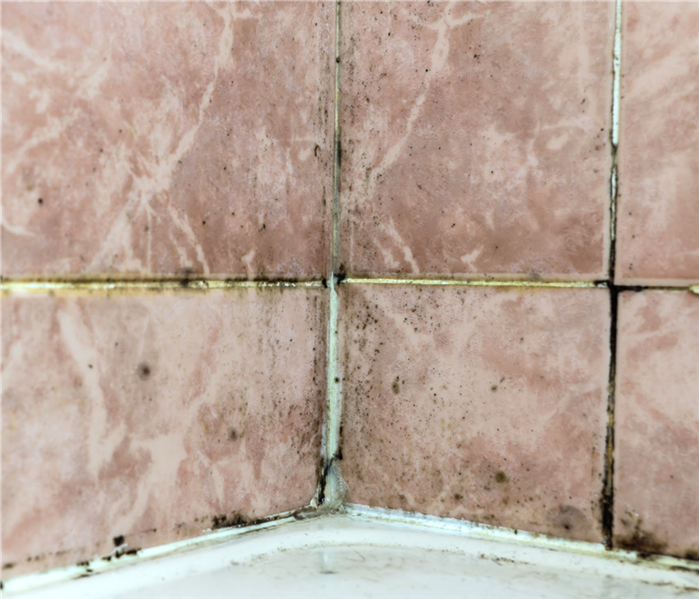 Mold damage in a bathroom
Mold damage in a bathroom
Preventing Mold Growth in the Bathroom
The bathroom of your Elburn, IL, home is likely to experience mold growth at some point. This could result from a water damage event, such as a pipe break or leak, or general high humidity. Understanding what causes mold can help you better prevent it from occurring.
Necessary Conditions
It may seem like mold can grow anywhere, but there are several factors that must coexist before a fungal infestation occurs. Mold needs the following to grow:
Unfortunately, food sources for mold are abundant, and most indoor locations are sufficiently warm to sustain fungi. Water is the prerequisite for mold over which homeowners have the most control.
Preventive Strategies
The bathroom is often the most humid room in a home, making it exceptionally prone to mold growth. Mold prevention relies heavily on keeping the area as dry as possible. Clean up water damage as soon as possible. For extensive damage, it may be necessary to enlist the help of a professional restoration team with the tools and experience to address the issue quickly and thoroughly.
If your bathroom is equipped with an exhaust fan, turn it on before taking a shower and for approximately 30 minutes afterward. If you do not have an exhaust fan, opening the window after you get out of the shower allows the humid air to escape. A portable dehumidifier can be run on days when the outdoor humidity is too high to open the windows.
If your bathroom has grout, apply a sealant once a year to minimize water penetration and scrub the grout regularly to remove any mold growth before it spreads. Mold-resistant paint can be applied to the walls and ceiling to minimize the opportunity for mold to colonize those locations. Other surfaces can be sprayed with a mold inhibiting spray.
Mold prevention may seem complex in a room as humid as the bathroom, but a few simple steps can streamline the process. Keep the bathroom as dry as possible, clean up water damage quickly, use mold inhibiting products and clean up visible mold before it spreads.
Restoration Companies Service Both The Client and The Adjuster
2/24/2021 (Permalink)
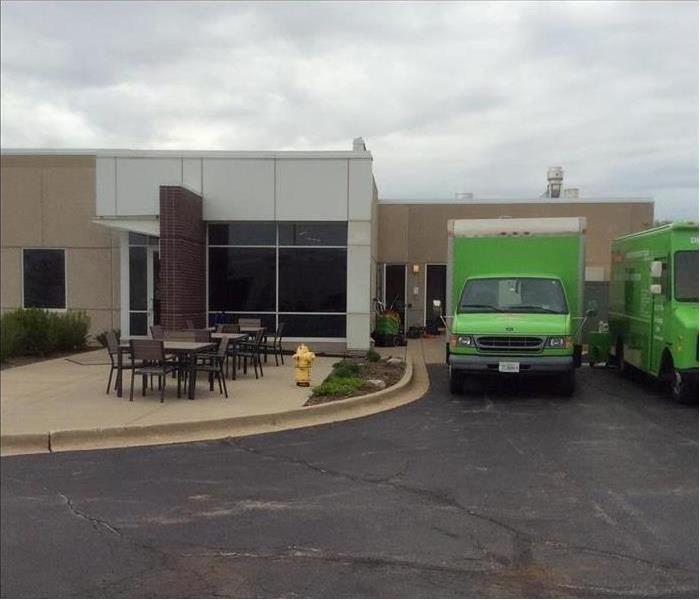 Call SERVPRO of St. Charles/Geneva/Batavia we can help.
Call SERVPRO of St. Charles/Geneva/Batavia we can help.
Is a restoration company working for the client or the insurance adjuster? It's tempting to think that the operation is designed to fight solely for one side. The business relationship, however, is symbiotic, supporting all of the involved parties. Here's what the establishment does and why they're right for everyone.
What Does a Restoration Company Do?
A restoration business is a one-stop-shop for water damage repairs. Designed to serve multiple needs, establishments such as SERVPRO house specialists in various fields, offering assistance throughout an entire project. By having everyone connected to one place, cleanup is streamlined for efficient project management. Organizations start the job and finish it, following through on all of the following demands:
- air and structural testing
- drying methods
- content cleaning
- mold contamination and cleanup
- building repairs
- vent cleaning
How Does This Connection Benefit Owners?
An insurance adjuster requires specific documentation before financial assistance is permitted. When owners use multiple companies to tend to different projects, this complicates matters and slows approval. Remediation crews step in and aid in this process. The specialists from the first moment begin to take photographs and assess the premises, noting conditions within an electronic system. This information is then sent overall as one, saving proprietors time and headache. Owners step back and have someone take over the hassle.
How Does the Service Assist Insurers?
An insurance claim should arrive in the appropriate language and with the necessary support. Armed with this awareness, staff create submissions in the correct format. This avoids rewrites, frustration and delays.
Also, certified professionals determine what is wrong on the property and how the trouble should be repaired. Following national standards, insurers may trust the team to complete the work accurately.
Of course, keeping costs down is vital. A water restoration company arrives immediately to secure and contain the premises. These actions and the effort to salvage what is possible reduce the overhead.
A claim doesn't have to be a battle between the insurance adjuster and owner. When a remediation company is hired, communication improves, and workload lessens, creating a desirable collaborative union for commercial owners and insurers.
5 Steps To Make a Mold Claim
11/30/2020 (Permalink)
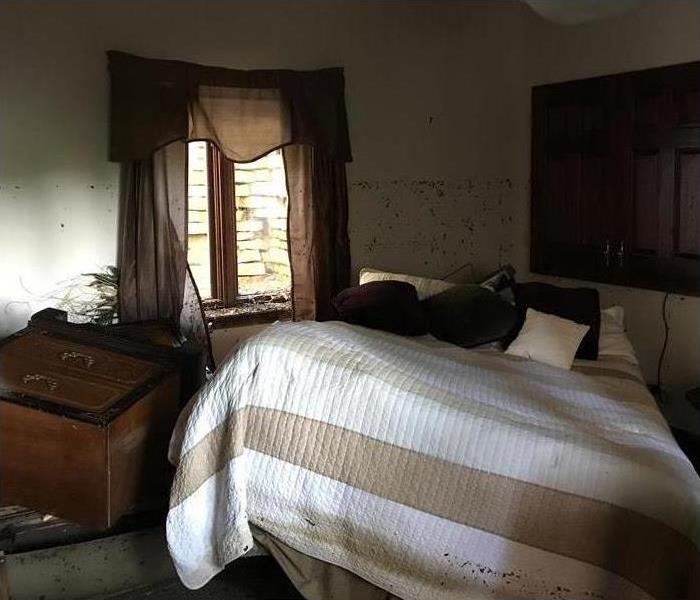 Bedroom with mold damage
Bedroom with mold damage
Take These Five Steps To Make A Mold Claim
A covered mold claim can save thousands of dollars that a homeowner would otherwise have to pay out-of-pocket for cleanup and remediation. Residential property owners may assume homeowners insurance covers fungus growth, but many policies exclude or cap mold coverage.
1. Make Sure Mold Is Covered
Homeowners should review their current coverage to determine whether additional mold insurance is necessary. Many homeowner’s policies cap or cut out coverage for secondary damage resulting from primary water damage that was improperly restored. Endorsements, riders and additional policies may provide mold coverage with independent terms and limits.
2. Document Mold Damage
When you see mold growing in your home, document the damage in preparation for making a claim. A mold inspection professional can safely obtain footage of hidden fungus growth behind walls or in other hard-to-reach locations with specialized photographic equipment.
3. Make a Mold Insurance Claim
A homeowner should submit proof of damage and any other helpful documentation when making a claim. Within the stated limit of a claim, more costs may be covered if a homeowner can provide records of water damage restoration and ongoing upkeep of plumbing and other structural systems.
4. Schedule Cleanup and Remediation
Cleanup and remediation should take place as soon as possible after the detection of mold in a residence. Certified mold specialists can remove colonies and ruined building materials, disinfect and apply antifungal treatments to surfaces and clean some contents exposed to mold.
5. Take Preventative Measures
A homeowner should take any measures necessary to keep mold from returning to a residence. Fixing plumbing or roofing problems and restoring water damage can keep fungi from multiplying.
Fungus growth poses a problem for many households in St. Charles, IL. If you see or smell signs of mold growth, contact certified professionals. Timely action can limit the spread of mold throughout a residence.
Why Does Mold Keep Coming Back?
10/8/2020 (Permalink)
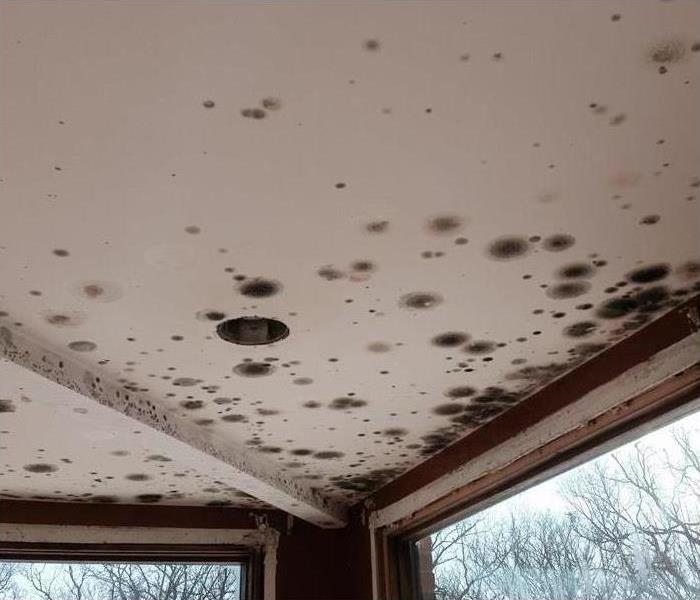 Mold damage in Geneva, IL
Mold damage in Geneva, IL
Three Reasons Why Mold Might Be Coming Back
Mold is notoriously tricky to get rid of. Even after you’ve scrubbed and cleaned your house, you might find green or black mold spots. Recurring mold is especially common in homes that have water damage.
Do you have a persistent mildew problem in your Geneva, IL, home? Here are three reasons mold might be coming back.
1. Dirty Ducts
Mold is microscopic and can easily float on air currents. You may have cleaned all the damaged surfaces, but if the mildew is in your air ducts, they may spread through your house when your HVAC system is on. If the air throughout your home smells musty, you may have mold in your air ducts. If the area is small enough, you can clean it yourself with a mixture of bleach and water. If the affected space is larger than 10 square feet, have a licensed professional perform the mold cleanup.
2. Moisture and Humidity
Controlling moisture is essential in getting rid of mold, as it grows best in humid or damp places. According to the US EPA, mold can start growing in as little as 24 hours on a wet surface. Quickly fixing leaks and drips will reduce the chance of dealing with contamination, such as black mold, again. Keep the humidity inside your house below 50% by running a dehumidifier or weatherizing your home.
3. Wet or Damp Items
Mold feeds off organic materials such as wood and fabric. Because carpets, drywall and upholstery can retain water, thoroughly dry or replace them after a flood or a burst pipe. Mildew can hide under wallpaper – take care when taking it down so the spores don’t spread through the room. Use bleach for surface cleaning, and run fans or dehumidifiers to dry paneling and flooring.
Despite your best efforts, you may not be able to get rid of all the mold yourself. If you suspect your home has damage, contact a mold remediation company. They can contain and remove contaminants such as black mold from your home.
5 Steps for Mold Remediation at Your Business
9/3/2020 (Permalink)
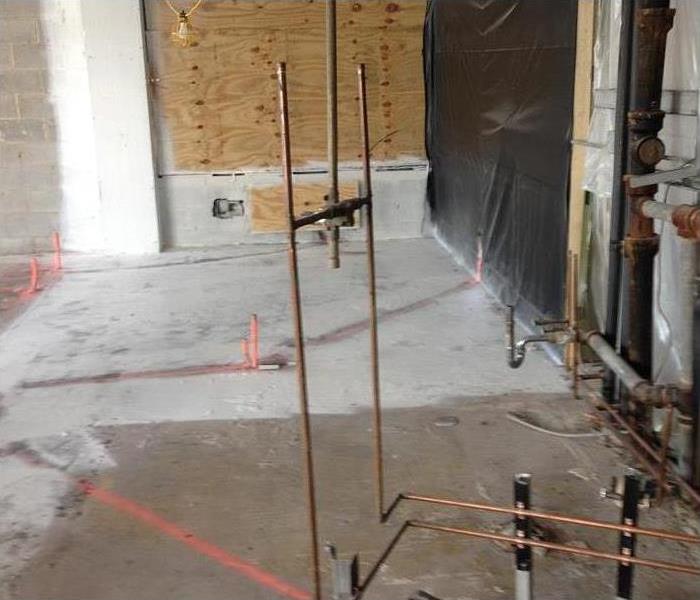 Mold containment in North Aurora, IL
Mold containment in North Aurora, IL
Mold Remediation Process
If you’ve found black mold at your North Aurora, IL, business it’s best to contact a local mold remediation service as quickly as possible. These professionals can contain the problem, remove the mold, and clean the space. Here’s what you can expect to see during this process.
1. Damage Assessment
The first thing you will often see a remediation service do is to perform a damage assessment. This will involve testing for mold to determine where it is and what type they are dealing with, as well as making plans for remediation.
2. Mold Containment
Containment is an important part of mold remediation as it’s a step that helps prevent further contamination of the space. This step usually involves sectioning off the affected area with plastic sheeting and using a ventilation system to control airflow.
3. Mold Removal
The next step should be the removal of the black mold. In this part of the process, the professionals doing the remediation may remove any surface the mold has contaminated including portions of walls and flooring if necessary. Once the affected materials are out of the area the space can be thoroughly cleaned.
4. Item Cleaning
During the mold cleanup, office items will also need to be cleaned. Each item may have a different cleaning process depending on the size and material type. They will then be moved to content storage until it is safe to return them to the space.
5. Restoration
Once the mold is removed and the space cleaned, the restoration process can begin. This step involved replacing any removed components with new material to return your business property to pre-mold conditions.
When removing black mold from a business, the remediation professionals will often start with a damage assessment. The nest steps include containing the affected area, removing the mold, cleaning any affected items, and making repairs. With a little effort, they can have your business looking “Like it never even happened.”
When Mold Damage Is Covered Under a Homeowners' Insurance Policy
7/28/2020 (Permalink)
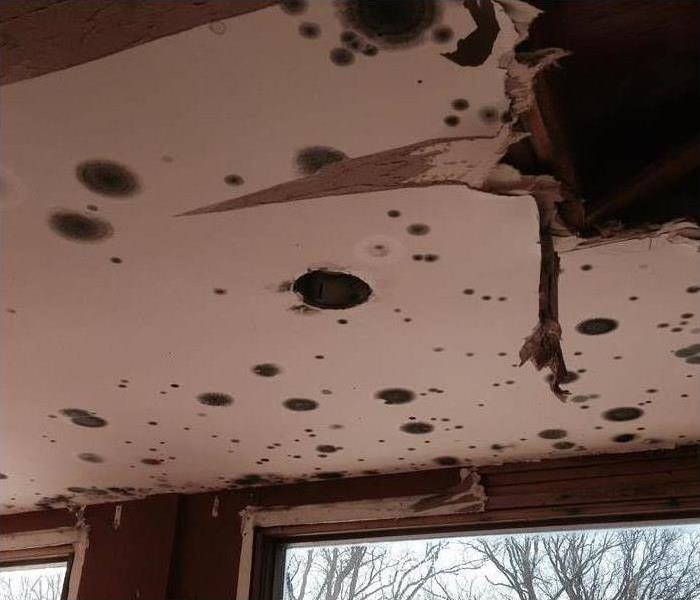 Mold damage to ceiling in a Geneva, IL home
Mold damage to ceiling in a Geneva, IL home
When Is Mold Damage Covered?
If you have a hidden moisture issue in your home, you could soon end up with a bigger problem: fungus growth. Mold, in particular, spreads quickly in wet areas. By the time you discover the mold, it may already be widespread throughout your Geneva, IL, house.
Attempting to clean the mold yourself can make the problem worse. However, mold remediation professionals can remove the spores and help prevent them from coming back. Your homeowners' insurance may even pay for this cleanup.
Checking Your Insurance
Most insurance policies do not directly include mold coverage. Still, your insurer should pay for mold-related expenses if the mold resulted from a covered peril such as:
- Vandalism
- Lightning
- Theft
- Fire
- Frozen pipes
- Accidental discharge of water from appliances, sprinklers or plumbing
Even if the fungus growth did not result from a covered peril, you may still have some limited coverage in your homeowners' policy. The insurer may only cover certain services or just pay a portion of your expenses.
You can also purchase mold insurance as an endorsement, or add-on, to your homeowners' policy. Keep in mind, however, that the insurer may reject your endorsement request if your home has a history of mold problems.
Filing a Claim
If you do think your mold damage is covered by your insurance, you need to file a claim as soon as possible. You should also take steps to mitigate further harm to your home. Otherwise, the insurer may decline your claim.
You should avoid getting too close to the mold. However, you should open doors and windows to dry out the wet areas. You should also stop any active leaks that may be fueling the mold growth.
Mold that results from a sudden peril such as fire or lightning may be covered by homeowners' insurance. You can also purchase a separate mold endorsement to your policy. To ensure that your insurance claim is accepted, take steps to reduce the fungus growth before the mold cleanup experts arrive.
The Importance of Qualifications for an Insurance Company
6/11/2020 (Permalink)
 Water Damage Cleanup
Water Damage Cleanup
The Importance of Qualifications for an Insurance Company
As an insurance agent, you know it helps to partner with the best remediation company in Elburn, IL. Therefore, you look for a company that has high standards and meets your qualifications. In a word, it is all about professionalism. That's why SERVPRO is the preferred vendor for many local and national insurance companies in the U.S. and Canada. Not only is the company Faster to Any Size Disaster, it also embraces a higher standard of cleaning and restoration. Each of the 1700 franchises have the training and knowledge to deal with the following situations:
- Water damage
- Fire damage
- Mold mitigation
- Storm damage
- Commercial and residential services
An established vendor program makes sure you get qualified workers to help your clients in times of trouble. A fast response and quality work are the hallmarks of a professional disaster remediation company.
High Qualifications
A reputable restoration company goes beyond the normal methods of a typical cleaning or janitorial service. Trained technicians use advanced techniques and a variety of cleaning methods to make sure a business is completely restored. Highly-trained professionals are experienced in biohazard decontamination, chemical spills, and other challenging circumstances. They adhere to the standards of the Centers for Disease Control and other advisory agencies such as the IICRC. All of this helps an insurance agent reassure customers that everything is being done to restore a business to its condition before a fire or flood.
Best Practices
Every insurance agent will appreciate the effort to keep costs low and to reduce expenses. When possible, damaged items should be restored instead of replaced. This can be accomplished through pretesting of items and the proper cleaning techniques for materials. Methods such as dry cleaning, deep cleaning, and immersion cleaning can restore damaged items such as clothing, carpeting, upholstery, and personal belongings. It always pays to work with a trusted leader in the cleaning and restoration field.
What Methods Are Used To Contain Mold?
5/13/2020 (Permalink)
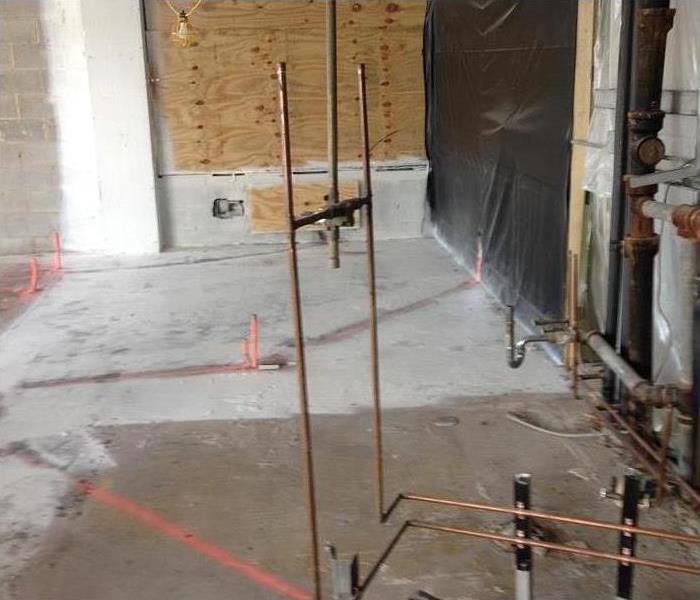 Mold containment in Geneva, IL
Mold containment in Geneva, IL
An HVAC system or occupants of a building can carry airborne mold spores. Building owners or managers should turn off the central air system and restrict traffic in and out of areas that are suspected or known to be infested with mold. Remediation professionals use the following containment methods during mold cleanup.
Suspending Polyethylene Sheeting
Heavy sheets of plastic are used to isolate a portion of a structure with mold contamination. Plastic sheeting at least 6 millimeters thick may be used to seal off any of the following portions of a structure:
- Doors and openings
- Flooring in the work area
- Ventilation returns and vents
Duct tape or painters tape can be used to create a seal that will ensure that air does not circulate out of the contained area and into the rest of the structure. If necessary, epoxy or studs can be used to suspend sheeting in large areas.
Generating Negative Air Pressure
An exhaust fan with an attached high-efficiency particulate air filter can vent air out of the area in which mold cleanup is taking place. HEPA filters are rated to remove at least 99.7% of particles, including fungus spores. This equipment reduces the concentration of spores and provides negative pressurization within a sealed work area surrounded by sheeting.
Creating a Full Containment Airlock
Plastic sheeting can also be used to set up a two-barrier airlock if full containment is necessary for an infestation affecting more than 100 square feet of a structure or involving toxigenic mold. A decontamination chamber will help remediation professionals avoid carrying spores out of the work area.
Containment is an essential part of mold cleanup. Failure to limit access and put up physical barriers around an infestation may permit mold spores to travel throughout a building in Geneva, IL. Any areas with elevated moisture levels can support growth and cause mold to spread.
We are Cleaning Experts
3/17/2020 (Permalink)
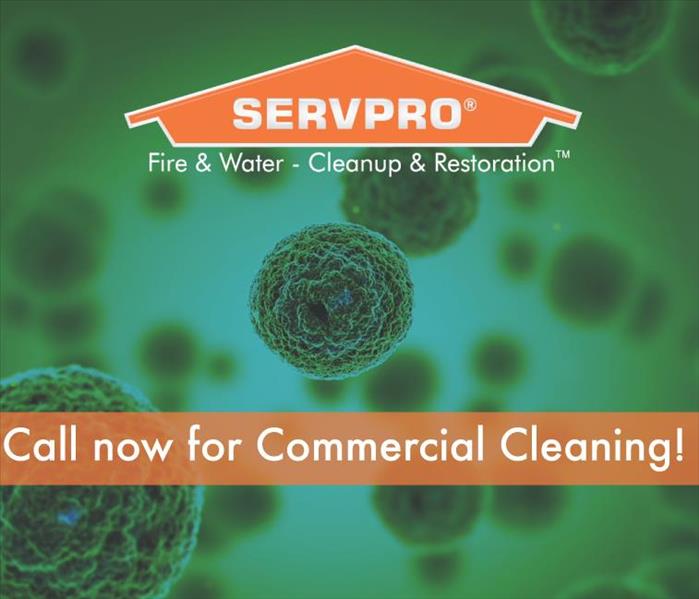 We are here to help!
We are here to help!
SERVPRO is Here to Help during this time of need
During this unprecedented time caused by the global pandemic of coronavirus, this is a reminder to our customers that we are specialists in cleaning services, and we adhere to the highest cleaning and sanitation standards.
Specialized Training
We are prepared to clean and disinfect your home or business, according to protocols set forth by the Centers for Disease Control and Prevention. We have years of experience in dealing with biological contaminants, and we will go beyond the scope of work that regular janitorial staff perform on a daily basis.
The CDC encourages cleaning of high-touch surfaces such as counters, tabletops, doorknobs, light switches, bathroom fixtures, toilets, phones, keyboards, tablets and tables. Other spaces mentioned in the CDC’s guidance for commercial spaces include:
- Kitchen/Food Areas
- Bathrooms
- Schools/Classrooms
- Offices
- Retail Spaces
- Water Fountains
- Shelving/Racks
- Sales Counters
- Carpets and Rugs
- Stair Handrails
- Elevator Cars
- Playground Equipment
- Fitness Equipment
Specialized Products
The CDC recommends usage of a labeled hospital-grade disinfectant with claims against similar pathogens to the coronavirus. Multiple products in the SERVPRO product line carry the EPA-approved emerging pathogens claims. While there is currently no product tested against this particular strain of the coronavirus, we are following all guidelines as provided by the CDC and local authorities.
Call Today for a Proactive Cleaning
If your home or business needs deep cleaning services, call the experts today – SERVPRO of St. Charles/ Geneva/ Batavia- (630) 377-7062
Why Call SERVPRO?
2/13/2020 (Permalink)
 Let us handle it for you.
Let us handle it for you.
Here at SERVPRO of St.Charles/Geneva/Batavia, we realize you have many options when selecting a restoration and emergency service provider. So, why should you call us?
- We are a one stop shop that can handle any job from start to finish.
- As one of 1700 individually owned and operated franchises we have access to more support during harsh weather.
- We are “Faster to any size disaster”.
- SERVPRO is a trusted name in the mitigation and restoration industry.
- We work with all major insurance carriers and have relationships with many local providers.
- We are a Large Loss Provider.
- We always put our customers need first.
- We have the equipment and training to get any job completed.
- We can easily handle both commercial and residential properties.
- Open 24 hours a day, 7 days a week, 365 days a year.
- We are locally owned and operated so we live and work in the same communities you do.
- We love what we do and want to help you!
If you have questions, need any assistance or would like a free estimate. Give us a call today (630)377-7062.
Eliminating Mold Odor
2/4/2020 (Permalink)
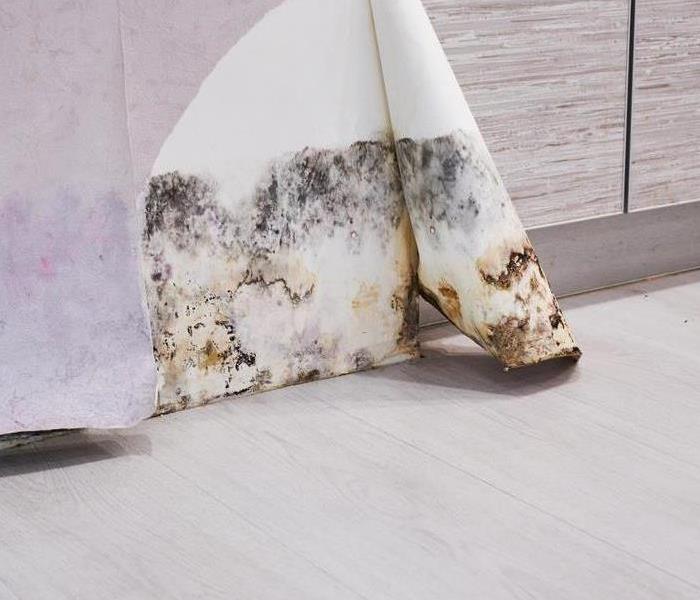 We can find hidden mold and remove it, eliminating mycotoxins and the lingering odor.
We can find hidden mold and remove it, eliminating mycotoxins and the lingering odor.
If your St. Charles, IL business has ever suffered a mold infestation, then you may have experienced the musty smell frequently associated with mold growth. This odor is caused by the mycotoxins released by mold spores. Fortunately, removing the mold will eliminate the smell.
Temporary Solutions
Covering up the smell of the mold may help in the short term, but remember that the smell will keep coming back until the mold is removed. The following are items that may help with the smell but will not address the underlying problem:
Candles
Incense
Air fresheners
Non-moldicide cleaners
These products may help your business smell fresher, but they should not be used long-term. The longer you wait to remove the mold, the worse the infestation will be and the more damage it will cause.
Mold Remediation
The only way to eliminate the musty odor permanently is to thoroughly remediate the mold using a professional mold remediation company, such as SERVPRO of St. Charles/Geneva/Batavia. It is impossible to remove all mold spores because they are present nearly everywhere. However, it is possible to clean mold growth well enough to eliminate the odor caused by the mycotoxins. To clean mold, the experts at SERVPRO will first address the moisture source and make sure the area is dry. It is important to turn off the HVAC system and any fans to keep the spores from spreading throughout the building. Run an air purifier with a HEPA filter to trap the free-floating mold spores.
If you have removed all the visible mold and still detect a musty odor, then you may need to call an experienced restoration team.
Restoration After a Fire
12/30/2019 (Permalink)
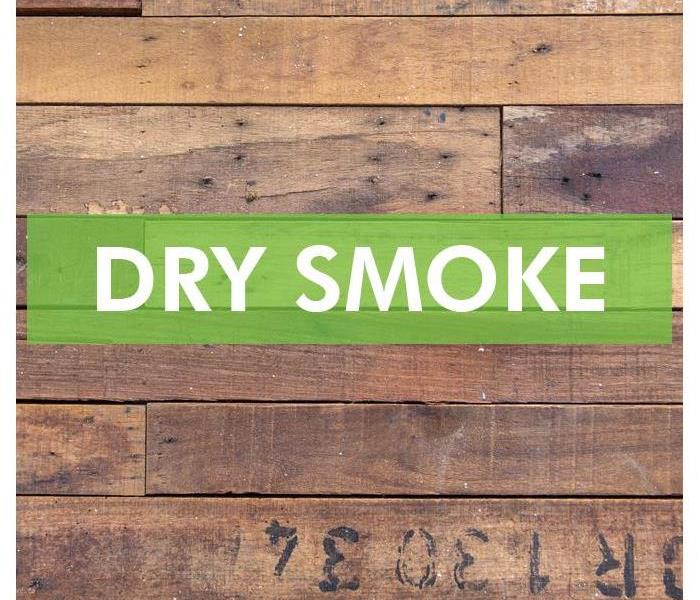 Sources of dry smoke residue are wood and paper
Sources of dry smoke residue are wood and paper
The aftermath of a fire in you Geneva, IL, can run the gamut from minimal damage to a total loss. Even if the damage doesn’t fall on the extreme end, there could be hidden fire loss that will need to be taken care of to get your business back to looking “Like it never even happened”.
Types of Damage
Along with the obvious signs of fire damage, smoke damage is a main cause of long-term concern. While some may be visible, it sometimes just leaves a smoky smell behind without being seen. There are four main types of smoke damage.
Dry Smoke – The result of a paper or wood fire, this type leaves a powdery residue that is relatively easy to see and clean. Unfortunately, it contains tiny particles that can embed themselves in porous materials, creating the lingering scent of fire.
Protein Residue – Usually associated with low-heat cooking fires, it is difficult to visibly detect but permeates a consistent smoky odor if not treated.
Fuel/Oil Residue – Although uncommon, this is dense, sticky residue that is difficult to clean and leaves a strong, pungent smell.
Wet Smoke – If plastic and rubber catch on fire, the sticky smoke can quickly spread across an entire room. The smearable residue is tough to clean without special equipment.
The Cleanup Process
Whatever the level of your fire loss, fire restoration is available that can eliminate the lingering odors, as well as help you salvage a number of items. A restoration specialist has the expertise and equipment to remove soot, smoke damage and odors from furniture, documents, drapes, furniture and more. These professionals also have the know-how to replace and repair structural damage to get your business back up and running as quickly as possible.
While dealing with fire loss can be overwhelming, getting the right can help ease the disaster. Count on a professional to help you restore things back to normal.
3 Effective Ways To Reduce Mold Risk at Home
11/27/2019 (Permalink)
Reducing Mold Risk
Mold needs an ample amount of moisture, warmth and oxygen to grow in St. Charles, IL homes. Therefore, it is most common in places where water damage goes untreated or when humidity is too high. Even though water particles are always around you, there are ways you can reduce moisture, which can decrease the risk of mold growth in the process. Continue reading to learn how you can prevent mold development in your house.
1. Repair Any Leaks
Not every part of your home can function properly, and sooner or later, something will break. This extends to your plumbing system, roof and window. Leaks and cracks to these parts can bring unwanted water and humidity inside, which can encourage mold. It is important to actively look for pipe, roof and window damage and repair it as fast as possible. Mold can even warn you of damaged pipes behind a wall, for example.
2. Clean and Dry After Flooding
A flood can invade your home for a variety of reasons, from a pipe leak to excessive precipitation. Once the flooding stops and it is safe to move around, it is time to repair the water damage. Drain the contents and clean as much of the water as possible. Dry any affected surface and ventilate the area to expedite the process. Contact emergency restoration services to ensure the job is efficiently done with the right expertise and equipment.
3. Control the House's Humidity
Even if you are attentive to the house's faults and mitigate the damage, your mold prevention plan can go further. High humidity, coupled with oxygen, food and other elements, can be enough to result in mold. Use a dehumidifier or an air conditioner to keep humidity at 50% or less. Keep up with temperature changes to adjust these devices throughout the day.
Mold thrives in moist environments, such as places affected by water damage and excessive humidity. Control this moisture to stop mold growth in your home.
Why Does Food Get Moldy?
9/23/2019 (Permalink)
 bread mold grows quickly
bread mold grows quickly
How Does Bread Mold Begin to Grow?
What makes leftovers that are lurking in the back of the fridge turn into a science project? Mold is a microscopic fungus, a plant, that is found everywhere on earth, including Elburn, IL. We are surrounded by mold spores traveling through the air looking for a home.
Home Sweet Bread
Bread is an inviting host for traveling spores. White bread is made of simple carbohydrates that turn to sugar, which is a very efficient food source, and once a colony gets established, bread mold grows quickly. The best environment for mold growth is cool, damp and dark with poor air circulation — in other words, a refrigerator.
Chilling Out
As with other plants, mold can only survive in a limited range of circumstances. If temperatures are too cold, such as in the freezer, growth stops. Warm conditions, such as baking in an oven, have the same effect. But the humid, dark, still interior of a refrigerator is the perfect place for mold. The best way to prevent mold growth is to eat food while it is still fresh before fridge mold starts to grow.
Useful Mold
Mold is not always bad and has actually saved lives. For example, the antibiotic penicillin was first cultured from mold. Some cheeses, such as Roquefort and blue cheese, rely on mold for their distinctive flavor and appearance. A fungus growth on corn is called huitlacoche in Mexico and is considered a delicacy.
The next time you open a bag and find that bread mold has staked a claim, remember that mold is everywhere in the air around us. The only way to prevent it is to buy smaller amounts of food more frequently so that they can be eaten before mold growth starts. Failing that, you can freeze leftovers. In the event that you have a more serious mold problem, such as mold growth on drywall after a flood, then it's likely time to enlist the help of a professional mold remediation service.
Why Bleach Doesn’t Effectively Remove Mold
7/25/2019 (Permalink)
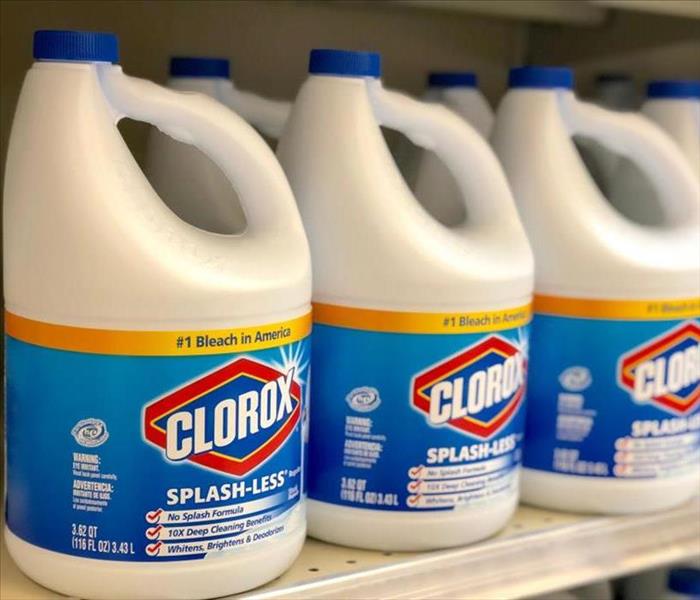 Don't use bleach to clean up fungus
Don't use bleach to clean up fungus
For many business owners, bleach is the go-to method of mold and fungus cleanup. Whether it’s small spots under the bathroom sink or a large area of water damage from a leaking roof line, mold cleanup can appear to be quick, easy and sanitary with the use of surface cleaning products. However, these products only remove the surface of mold and can’t get at the roots. Find out how to effectively remove mold in Elburn, IL, today.
The Problem With Cleaning Supplies
The issue with most commercial cleaning supplies is that they only address the surface problem. Chlorine bleach is an effective way to remove mold from the surface, but here are a few reasons that it isn’t the best way to thoroughly disinfect your commercial building:
- Chlorine can evaporate
- It can’t reach the roots of mold
- It can be dangerous if used improperly
Instead, here are some ways to properly cleanup mold and fungus in your commercial property. When you choose a commercial solution, you’ll enjoy fast and efficient results.
Effective Mold Removal
Fungus cleanup should start with an experienced cleanup company that is Here to Help. There are a range of commercial cleaning supplies that are able to reach the deepest roots of mold while still keep your air quality safe.
Hydrogen peroxide, vinegar, borax and even tea tree oil are all natural ways to remove surface mold. However, deep cleaning requires professional-grade biocides. These tough cleaning solutions aren’t easily available, but a commercial mold remediation company has access to all the gear and cleaning supplies necessary to effectively rid your storefront or office building of any mold buildup.
Discover how you can receive prompt, professional fungus cleanup today. Don’t use bleach or other harmful chemicals to attempt to clean it yourself, but choose a company who is able to provide the effective cleaning solutions and techniques that can target the roots of mold and leave you with a clean, sanitary surface.
How Does Pretesting Affect Claims?
3/24/2019 (Permalink)
Pretesting can help to determine the full extent of damage to a property before mitigation starts. This preliminary step may increase the accuracy of an initial estimate and could ultimately reduce the total amount of an insurance claim. Learn more about how early testing can potentially impact a claim.
Improving Estimate Accuracy
Preliminary testing can determine the types and precise extent of damage at a property in Batavia, IL. This method goes beyond visual inspection. Mitigation experts may take any of the following measures:
- Testing surfaces for damage
- Searching for signs of secondary damage
- Inspecting adjoining areas
Pretesting can identify the presence of additional damage that might otherwise be overlooked. Undetected damage could result in serious problems or significantly increase an estimate if it is discovered during mitigation or restoration.
Identifying Additional Damage
Preliminary testing can also determine whether other types of damage are present. In the case of a fire, this may involve additional smoke or soot damage that has traveled through ductwork to other parts of a structure or water damage from extinguishing efforts. In the event of water or storm damage, mold or other secondary damage could be identified through early testing. This damage can then be factored into an initial estimate and work schedule.
Keeping Work On Schedule
If any additional damage is discovered in the midst of mitigation or during restoration, it may add time to the duration of the process. This may result in higher claim amounts for property insurance and possibly also business interruption. Preliminary testing can account for all of the damage that is present at the start of the process.
All of these factors make pretesting well worth any additional expense or time. A property owner or insurance agent should insist on the importance of a thorough initial inspection, particularly when dealing with major damage caused by fire, water or storms.
Mold Remediation: Why Hiring a Professional Is Often Necessary
3/6/2019 (Permalink)
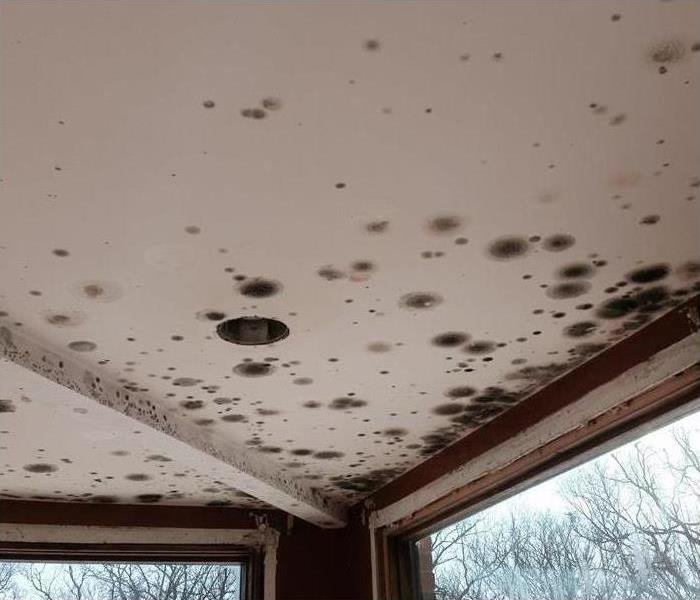 Mold damage in a ceiling after water damage.
Mold damage in a ceiling after water damage.
Is It Necessary To Hire A Professional?
Mold removal may sound like a simple job, but nothing could be further from the truth, especially when dealing with an infestation. Mold spores spread quickly and easily, which means that in a contaminated home it is necessary to seal off registers and doorways to prevent the movement and cross-contamination of the mold species. However, beyond taking the appropriate precautions, hiring a professional for removal has other perks.
1. Pretesting
Reputable remediation experts will perform what is known as pretesting. This involves taking samples of all contaminated surface areas of the home as well as air quality tests. These tests allow experts to determine the mold species and the level of contamination. This determination then informs the remediation team on how to best move forward.
2. Prevention
Mold removal is not only about removing contaminated items and materials, but it is also about preventing the spread of the mold spores to other areas of the home. While spores are everywhere and virtually impossible to remove 100 percent, they can be reduced and controlled to prevent further and future damage to your home.
3. Removal
While some molds can be removed using cautious DIY techniques, black mold removal is not one of those species. In fact, some states and insurers require professional remediation for a black mold infestation to ensure the safety of you and others.
4. Restoration
A bonus to hiring a disaster restoration specialist in the St. Charles, IL, area for your remediation needs is the restoration part. These companies are a one-stop shop for remediation and restoration, meaning that your home will be free of mold and repairs when you get it back.
Mold removal can be a complicated job, one requiring professional assistance. Don't think that because a problem appears small and manageable than it actually is. Hire a professional to perform pretesting and learn about what you are dealing with, and then, if the problem is bigger than expected, hire a remediation and restoration team to take on the work. Stay safe and think of your health.
Regional Disasters Require a National Response
2/20/2019 (Permalink)
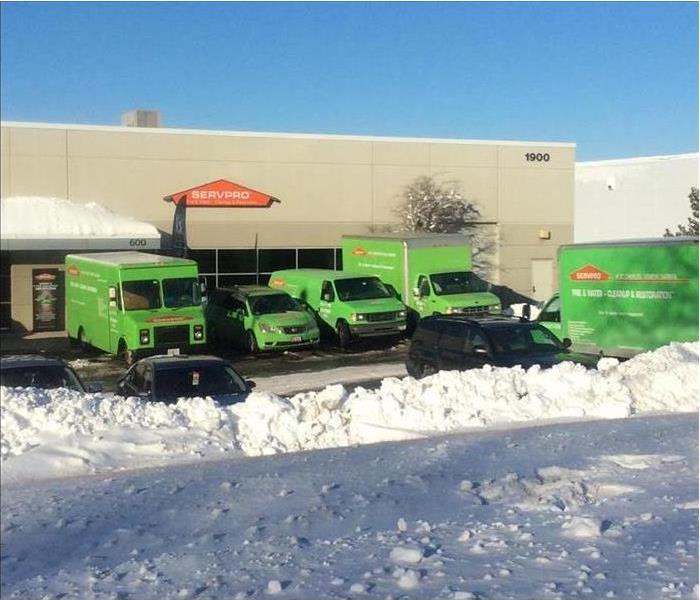 Contact the cleaning and restoration company that is faster to any size disaster
Contact the cleaning and restoration company that is faster to any size disaster
Regional Disasters
Regional disasters occur more often than we would like. Damage is usually extensive, and the region cannot recover without outside help. Even before the disaster is complete, the road fills with response teams from:
- Fire and rescue departments and agencies
- Power companies
- Cable TV and internet service providers
- Grocery and restaurant chains
- Hotels
- Medical facilities
- The cleaning and restoration company that is faster to any size disaster
There Are Many Different Ways To Respond to Disasters
The listed companies each respond to in their own way. Power, cable and emergency services have reciprocal agreements to send crews when needed. Grocery stores, restaurants and hotels take care of their own. Large hospitals and medical facilities assemble, equip and deliver teams of medical professionals.
One Company Takes a Unique Approach
The cleaning and restoration company takes a different approach. On a typical day, it looks like a group of over 1,700 independently owned and operated franchises. They deal with damage of all types including fire, water and storm. They perform cleanups and restorations in the nearby cities and towns. For the employees, it’s a peaceful day-to-day job.
Looks Are Deceiving
When disaster strikes, this company stands tall. Faster to any size disaster is not just a catchy phrase. Those home town franchises are part of a tightly connected network of providers. The central office of this network regulates all activity in the disaster area.
It begins with franchisees transferring teams and equipment to the disaster area. The company’s central office logs each insurance claim and assigns it to an appropriate team. In a disaster situation, the number and density of claims are high. Teams may find themselves working on multiple claims at the same time.
Make it Look “Like it never even happened.”
This is the ultimate goal of all cleaning and restoration projects. If you need this done in the North Aurora, IL, area, getting help is easy. Contact the cleaning and restoration company that is faster to any size disaster.
What You Need To Know About Commercial Mold-Removal Regulations
12/3/2018 (Permalink)
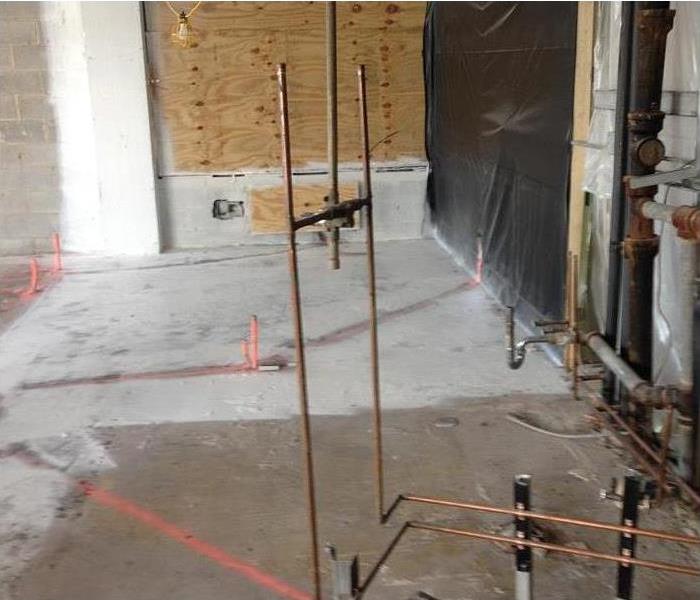 Mold containment in a North Aurora,IL building
Mold containment in a North Aurora,IL building
Investing in commercial property is usually an effective way to make money in North Aurora,IL. Of course, your rental property can only bring in income if you can attract tenants. As you probably know, mold growth has a way of driving tenants away. If you notice mold in one of your units, you must prioritize its removal. You must also be sure you comply with federal, state and local mold standards.
A Few Agencies Regulate Commercial Mold Removal
While black mold has developed a nefarious reputation in recent years, it isn’t the only type of mold that can devalue your investment property. When you are removing mold from commercial property, you must be careful to follow the law. A few agencies regulate the mold clean process, including:
- The Occupational Safety and Health Administration
- The Environmental Protection Agency
- State and local environmental agencies
OSHA’s mission is to keep employees safe at work. For that reason, the agency has developed mold standards that protect employee health. By contrast, the goal of the EPA is to safeguard the environment. Therefore, regulations from that agency direct the removal and disposal of mold and cleaning products.
A Nonprofit Certifies Cleanup Technicians
The Institute of Inspection Cleaning and Restoration Certification certifies mold-mitigation specialists. Those who pursue certification from IICRC learn about mold-removal rules and regulations. If you choose to contract with a certified technician, you can be certain your cleanup strategy complies with both OSHA and EPA regulations. Even better, because skilled technicians have the equipment and expertise to effectively remove existing mold and prevent future mold growth, you achieve peace of mind by leaving your cleanup to the professionals.
Few things can jeopardize the income potential of commercial property faster than mold growth. If you don’t comply with mold standards, though, you could further devalue your commercial investment. Rather than leaving your property to chance, rely on the expertise of skilled technicians who know how to remove mold legally.
4 Things You Should Know About Cleaning Up Smoke After a Fire
11/21/2018 (Permalink)
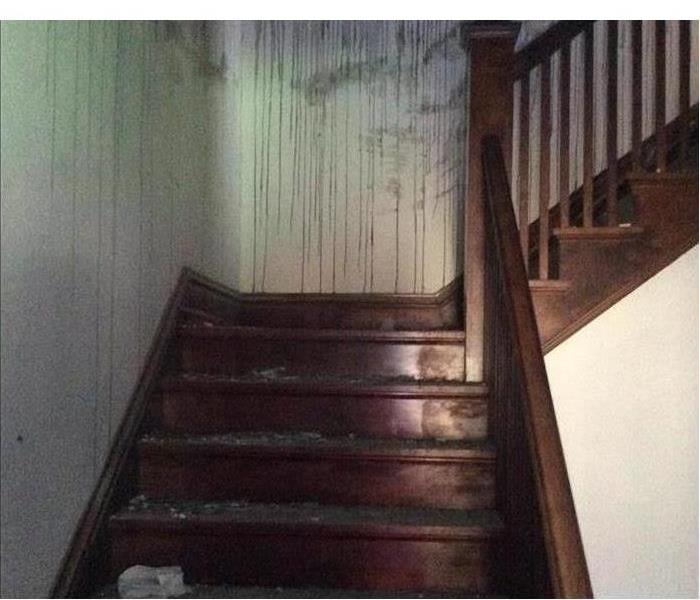 Soot damage in Geneva,IL
Soot damage in Geneva,IL
Dealing with Smoke Damage
The odor of smoke left behind after a fire can be irritating to skin and lungs, putrefying to your nose and stomach, and a sickening reminder of a traumatic event. But smoke damage and soot must be cleaned by someone trained to do so. Business owners in Geneva,IL, would be wise to call on professionals for help in dealing with smoke cleaning.
1. Damage from Smoke
Smoke damage alone may not mean the end of your belongings, but in some cases it may stain or saturate. For non-porous items, a thorough cleaning with an antiseptic may be all that is needed. Fabric items will need to be laundered, bleached or dry-cleaned to remove the residue.
2. Damage from Soot
Soot usually contains harmful compounds. It can be very sticky or greasy, making complete removal difficult. On hard-surfaces, soot damage might be scrubbed away with tri-sodium phosphate and detergent, while fragile or fabric items may be more difficult. A fire restoration company can be a great help in sorting it all out.
3. Chemical Residue from Electronics
The smoke from a fire, particularly at a business where plastics and electronics are used can have a high chemical content. Plastics give off an oily and irritating chemical when burned and smoke from burning electronics and wiring has a nasty, rancid fish odor.
4. Foul Odor
In addition to any stains and residue, smoke and soot can have a foul and lingering odor. Important papers and other porous, non-washable items may need to be placed in a tent with an ozone machine. Commercial ultrasonic purifiers may be necessary to help remove odor from furniture, walls, and floors. Air conditioning and filtration systems cleaned to prevent the residue and odor lurking there from causing problems.
Smoke cleaning is so much more than just dealing with the odor. Hiring someone in Geneva,IL, to perform a fire damage assessment and assist with the difficult cleanup issues that smoke damage causes can help restore your business and your peace of mind.
5 Tips for Preparing for a Storm
11/14/2018 (Permalink)
 Flood damage in a Elburn, IL home
Flood damage in a Elburn, IL home
Protect Your Home From Water Damage
The storms in Elburn,IL, can bring flood water to you home. This can cause a number of problems for both the house and your family. However, there are a few things you can do to protect your home from water damage.
1. Know What to Expect
One of the first steps is to know what to expect when it comes to flooding in your area. Perhaps you get a lot of storms, or a local river swells with the spring thaw? Are you at the bottom of a watershed? These factors can help you predict the likelihood of a flood in your area, as well as the water patterns. Knowing this can help you plan accordingly.
2. Keep Your Insurance Up-to-date
In many cases insurance plans will cover water damage. It’s important to keep your policy up-to-date as well as make sure you’re covered for events like flooding or storm damage.
3. Have Supplies Ready
If you think you may be dealing with flood water in your area it’s important to have supplies ready just in case. Think of things like medication or your pet’s needs, as well as what you will need if the power goes out. Extra batteries, a first aid kit, and protective gear are all important supplies to have on hand.
4. Protect Your Home
There are several ways to help prevent a flooded building. Preparations beforehand may include sandbagging doors, boarding over windows, or tarping over vulnerable areas.
5. Have a Plan for Cleanup
Having a cleanup plan before a flood happens can help save valuable time after the storm. Make contingencies for water removal, sanitation, and even repairs common to such events. You may even want to have the contact information for a local water damage and restoration specialist in case you need extra help.
Taking these steps can help you protect your home against flood water. Being prepared beforehand can also help you have a plan in place in case flooding does breach your property next time a storm in Elburn,IL, heads your way.





 24/7 Emergency Service
24/7 Emergency Service


























